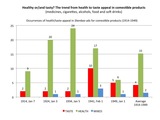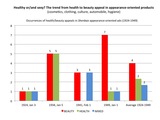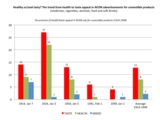| ID | Title | Description | |
|---|---|---|---|
 | 200 | Healthy or/and tasty? The trend from health to taste appeal in Shenbao advertisements for comestible products (1914-1949) | This set of bar charts measure the relative importance of two major appeals that were used to advertise comestible products at the time: health and taste/appetite, which either compete or complete each other. By "comestible products", we mean medicines, tobacco, alcholic drinks, food and soft drinks. The measurements were made from our usual five samples of the Shenbao (January 7, 1914; January 3, 1924; January 5, 1934; February 1, 1941; January 1, 1949). In each sample, we have recorded the occurrences of each appeal: health only (green), taste only (red), or a combination of the two appeals in the same advertisement (blue). The figures show that the "health" appeal remains predominant during the entire period (average of 15 occurrences, reaching a peak in 1934 (24 occurrences, while the taste appeal occured only two times). After a period of stagnation (two occurrences per issue in 1914-1924), the taste appeal dramatically raised in 1941 (10 occurrences), but fall again to 5 occurrences in 1949. Starting from 1924, health and taste appeals began to be combined (1 case in 1924-1934, 3 in 1941). The fifth following charts examine more closely to which products each appeal was specifically applied to. Obviously, health was constantly and systematically associated to medicines. Yet, it was also used to advertise alcohol in 1914 and nutritional products in 1924. As soon as 1924, alcoholic drinks were preferentially associated with taste, as it was the case for tobacco since 1914. Therefore, the "taste appeal" participated in the gradual association of alcohol and tobacco with pleasure. |
 | 201 | Healthy or/and sexy/trendy? The trend from health to beauty/fashion appeal in Shenbao advertisements for appearance-oriented products (1914-1949) | This set of bar charts measure the relative importance of two major appeals that were used to advertise appearance-oriented products at the time: health and beauty/sex appeal, which either compete or complete each other. Behind the phrase "appearance products", we mainly include cosmetics, clothing, culture, automobile and hygienic products. The measurements were made from our usual samples of the Shenbao (January 3, 1924; January 5, 1934; February 1, 1941; January 1, 1949). Jan 7 1914 was deliberately excluded since none of these products were represented in this issue. In each sample, we have recorded the occurrences of each appeal: health only (green), beauty/sex only (red), or a combination of the two appeals in the same advertisement (blue). The figures show that the "beauty" appeal remains predominant during the entire period (average of 4 occurrences, reaching a peak in 1949 (7 occurrences, while the "health" appeal occured only one or two times per issue). After a period of equal stagnation (one occurrences per issue for each appeal in 1924), the beauty and health appeals dramatically emerged in parallel in 1934 (5 occurrences for each one). In 1941, it fell to 3 occurrences, while the purely health appeal temporarily disappeared. Yet this was balanced by the combination of the health/beauty appeal (3 occurrences in 1941). The four following charts examine more closely to which products each appeal was specifically applied to. Before 1941, cosmetics were equally advertised as either "health" or "beauty" products, first mixed in the same advertisements (1924), then as separate appeals (1934). After 1941, cosmetics were exclusively advertised as "beauty" products. This confirms the cosmetics' gradual process of specialization and separation from medical products. Advertisements for hygienic products were more complex: they alternatively used health (1934) and beauty appeal (1934-1941), or a combination of them (1949). Less frequent than hygienic goods or cosmetics, other products prove difficult to trace on the long-term: culture/productivity, clothing and automobile appear to be systematically associated with social distinction. |
 | 250 | Healthy or/and tasty? The trend from health to taste appeal in the North China Daily News advertisements for comestible products (1914-1949) | This set of bar charts measure the relative importance of two major appeals that were used to advertise comestible products at the time: health and taste/appetite, which either compete or complete each other. By "comestible products", we mean medicines, tobacco, alcholic drinks, food and soft drinks. For consistency reasons, the measurements were made from the same five samples as used for the Chinese newspaper Shenbao (January 7, 1914; January 3, 1924; January 5, 1934; February 1, 1941; January 1, 1949). In each sample, we have recorded the occurrences of each appeal: health only (green), taste only (red), or a combination of the two appeals in the same advertisement (blue). |
 | 251 | Healthy or/and sexy/trendy? The trend from health to beauty/fashion appeal in the North China Daily News advertisements for appearance-oriented products (1914-1949) | This set of bar charts measure the relative importance of two major appeals that were used to advertise appearance-oriented products at the time: health and beauty/sex appeal, which either compete or complete each other. Behind the phrase "appearance products", we mainly include cosmetics, clothing, culture, automobile and hygienic products. For consistency reasons, the measurements were made after the same five samples as used for the Chinese newspaper Shenbao (except for January 7, 1914: January 3, 1924; January 5, 1934; February 1, 1941; January 1, 1949). In each sample, we have recorded the occurrences of each appeal: health only (green), beauty/sex only (red), or a combination of the two appeals in the same advertisement (blue). |
- RAW DATA
- COOKED DATA
- NARRATIVES
- REFERENCES
- DATABASES
4 documents
return to data set






















